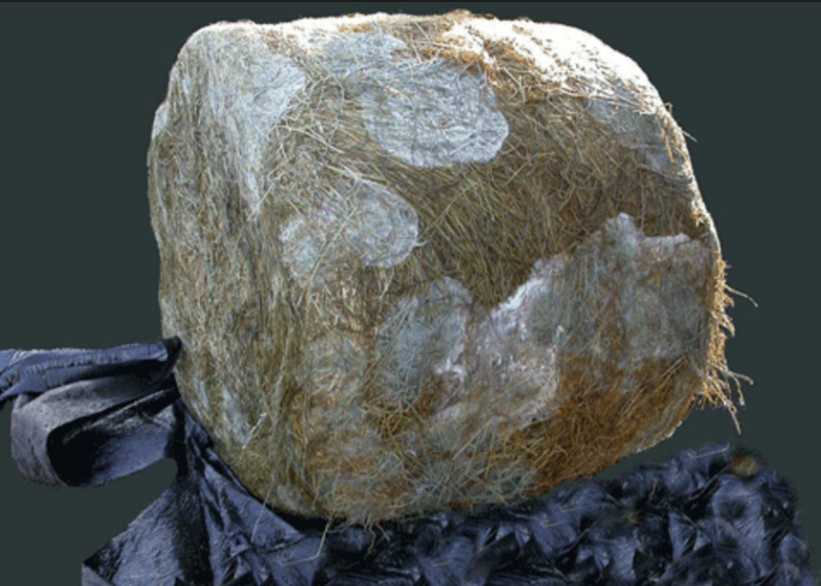
White Mould by production of Silage/Haylage Bales!!!
Winning the battle against white mould
When it comes to the production of silage bales, white mould is a very real and ever-present threat. Thankfully however, avoiding this unwanted fungal growth and protecting your fodder from the risk of spoilage is a relatively straightforward task. All that's really equired is that you adhere to a few simple steps.
The causes of white mould
In order to understand the solutions to white mould perhaps the best place to start is by understanding the problem's causes. As any expert will tell you, white mould usually appears when the conditions under which you are producing silage are not quite right.
To produce high quality silage, a number of factors have to be considered, including the dry matter content and quality of the crop being baled, and your choice of balewrap, which can influence the seal achieved around the bale. These factors are instrumental in creating a micro-environment within the bale. Get this micro-environment right and the lactic acid producing bacteria responsible for the fermentation process and, in turn, a good quality fodder will flourish. Get it wrong and the fermentation process will be hindered
and white mould can develop.
Choose a better bale wrap
As obvious as it might sound, your choice of bale wrap can have a major influence on whether white mould can take hold in a bale or not. White mould needs air to grow and for this reason it is always worth looking for a wrap that seals particularly well and thereby forms a more effective air barrier. One such wrap is bpi.argi's Silotite.
One of the reason for the exceptional popularity is the fact that this British-made product benefits from a unique two-sided tack. This feature ensures better sealing between each layer of wrap helping to revent air intrusion and in turn, white mould growth. On top of this, Silotite offers other benefits too. Its multi-layer construction gives it greater strength and enhaced resistance to impact and tears.
In addition, it enjoyes a uniform appearance at all stages of the baling process whilst its high-tack level reduces the occurrence of 'long tails' after wrapping. Then there's its cersatility. Solotite is suitable for almost any type of crop and can be used on round or square bales. Plus, it even benefits from in-built UV protection.
Yet despite its impressive performance, it alone is not enough to eliminate white mould growth. There still are other factors to be considered.
The importance of dry matter levels
The importance of the dry matter content of the crop being baled cannot be overestimated. To prevent white mould and produce good quality silage, the moisture level within the grass must be within a range favoured by the lactic acid producing bacteria responsible for the fermentation process.
If the grass is too dry and/or over mature and stemmy, the risk of mould growth increases due to insufficient or non-existent
fermentation. As a rule of thumb, you should aim for a figure of 30-50% dry matter (DM) for silage, whilst for haylage the figure rises to 50-60% DM. As DM levels increase from 60% towards that of hay (around 85%), so in turn do the risks of mould growth due to poor fermentation. It is therefore advisable to limit dry matter to a maximum of 60%.
The dangers of air intrusion
Alongside all the other influencing factors, the choice of a high quality balewrap and its correct application will help prevent mould growth by preventing the ingress of air into the bale. It is essential, therefore, in
creating an air barrier, to apply sufficient layers of balewrap.
For DM levels up to 50%, all areas of the bale must be covered with an absolute minimum of 4 layers of wrap. If the DM is higher, the number of layers should be increased to at least 6.
Indeed, current thinking now seems to support the idea of using at least 6 layers irrespective of the DM level; a notion that has been given credibility thanks to trial work conducted by IBERS (The Institute of Grassland and Environmental Research) during 2005.
During this research, IBERS found that applying 6 layers of black film to conventional silage bales significantly reduced the incidence of moulds in the bales compared with applying just 4 layers, and produced marked economic benefits.
And finally...
By and large, the most common cause of white mould is poor practice. Whenever it appears, most people are too quick to blame the wrap – perhaps because it is the most visible part of the process (unlike the less tangible elements of bacteria and air). The wrap however is merely a tool and like any tool it needs to be used correctly to deliver the best results. Part of this correct usage entails ensuring all the other basics have been satisfactorily considered and taken care of.
Ultimately when it comes to bale wrapping and the production of quality silage devoid of white mould one old maxim seems to ring true - that you need to start right to end right.
